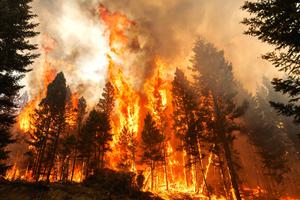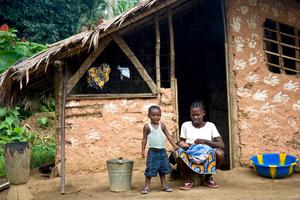Nearly 2,700 dam projects are planned or under construction from Slovenia to Greece.
After a written protest went nowhere, the village barricaded the bridge last August. Women were at the fore, arms locked defiantly. But that did not deter a riot control squad, which stormed the bridge, dragging the women away and kicking and punching those who resisted. Screams pierced the dawn, and arrests followed. Construction equipment crossed the bridge and commenced digging. But the remaining villagers regrouped and planted themselves in front of a backhoe, forcing the builders to retreat. The case currently is in court, and the women of Kruščica guard the bridge 24 hours a day.
The power station scheduled for Kruščica is just one of around 250 hydroelectric projects that have been approved or are under construction across Bosnia, and just a fraction of nearly 2,700 planned throughout the Balkan peninsula from Slovenia to Greece, according to a study by RiverWatch, a Vienna-based NGO, and EuroNatur, a German environmental group. Local residents, sportsmen, and international environmental groups are rising up against the wave of proposed dams in the Balkans, home to Europe’s last large assemblage of unspoiled rivers.
A detailed assessment of 22,000 miles of Balkan rivers commissioned by WWF and other conservation groups has classified 30 percent of the region’s rivers as pristine or “near-natural” and another 50 percent as in good condition. That contrasts sharply with the situation in Western Europe, where most rivers have been dammed or subjected to intensive development. Scientists and conservationists say that if the proposed scale of Balkan dam building proceeds, thousands of miles of waterways, home to scores of endemic or endangered species, will be irreversibly degraded and polluted.
Women in Kruščica, Bosnia and Herzegovina, have set up 24-hour protest camp to stop a hydropower project that would leave their village without drinking water. Andrew Burr / Patagonia
In countries known more for recent ethnic conflict than natural beauty, the researchers discovered intact ecosystems: free-flowing, crystal-clear rivers, steep primeval canyons, and rare flora and fauna, including the Balkan lynx, the Danube salmon (nearly wiped out in Central Europe), and 112 other species of endangered fish. The Balkans are home to 69 endemic fish species and contain more than 40 percent of all the endangered freshwater mollusk species in Europe. Damming the region’s wilder rivers disrupts the natural flow of the waterways, impedes fish migration, creates slow-moving reservoirs, and floods canyons and valleys. The dams also threaten many scenic, unimpeded rivers, arousing the opposition of rafters, kayakers, and anglers from Europe and beyond.
“This tsunami of dams will kill off some of the very last unspoiled, wild rivers in all of Europe,” says Ulrich Eichelmann, CEO of Riverwatch, one of numerous groups that have banded together in a coalition called Save the Blue Heart of Europe. Before the comprehensive assessment, says Eichelmann, “neither we nor the people [in the Balkans] were fully aware of what natural treasures these rivers are.”
Jörg Freyhof, a German biodiversity expert from the Leibniz Institute of Freshwater Ecology and Inland Fisheries in Berlin, says the vast scale of the dam building now takling place, or planned, in the Balkans could profoundly alter the region.
Dam proponents say the hydroelectric projects will supply badly needed renewable energy to the region.
“Dams completely change the ecosystem, turning a river into an artificial lake, and open the door for the invasion of alien species,” says Freyhof. “It’s comparable to cutting down a rainforest in terms of the strong negative impact on biodiversity. If many river ecosystems in a region are destroyed, then considerable numbers of species will be threatened with extinction. In the Balkans, one of the most important freshwater biodiversity hotspots in Europe, this is especially dramatic. Many species live only here.”
In addition to the environmental cost, “whole villages will be flooded, wiped off the face of the map, and livelihoods destroyed,” says Eichelmann. “And the motive isn’t sustainable energy, it’s pure greed.” He is referring to the corruption and kickbacks often associated with government public works projects in the Balkans, which encompasses all of Albania, Bosnia and Herzegovina, Bulgaria, Kosovo, Macedonia, and Montenegro, as well as parts of Croatia, Greece, Romania, Serbia, Slovenia, and Turkey.
Dam proponents say the hydroelectric projects will supply badly needed renewable energy to the region, which otherwise must depend on burning coal for electricity. Opponents say they do not object to all hydroelectric projects in the Balkans, but argue that far fewer should be built and only on the region’s less pristine rivers. They also say that other, less environmentally destructive forms of renewable energy, such as solar and wind power, should be given higher priority than hydro, much of which, they argue, is slated for export to Western Europe anyway.
Throughout the Balkan region, some 2,700 hydropower plants are currently under construction (yellow) or proposed (red). Map Courtesy of Save the Blue Heart of Europe
Eichelmann’s team found hydroelectric projects – many quite small, others as large as 250 megawatts – being planned in the middle of national parks and in other protected areas. Scores of dam and power station projects have been given the green light along waterways such as Bosnia’s Neretva River and its tributaries, the northern Sava River along the Croatian border, Montenegro’s Tara River, and in Macedonia’s Mavrovo National Park. Hundreds of tiny rivers, some little more than streams, are also slated for dam construction.
The boom in dam projects came to RiverWatch’s attention through Olsi Nika, an Albanian environmental biologist who was virtually alone in fighting the construction of hydroelectric dams — roughly 35 are planned or under construction — along the Vjosa River, a mighty, uniquely intact, and previously undammed waterway extending from the Pindus Mountains in Greece through Albania, and emptying into the Adriatic Sea.
European environmental groups, as well as the American outdoor apparel company Patagonia — which donates 1 percent of its sales to environmental causes — jumped into the fight. Patagonia, for example, funded Nika’s group, EcoAlbania, and is backing a new documentary film on the threatened rivers. The campaign in Albania raised public awareness in a country unused to green grassroots politics, forged a broad anti-dam coalition, and challenged the dams’ legality in court. And EcoAlbania won its first court battle against one of the largest approved dam projects along the Vjosa near the town of Poçem, a first victory of the Save the Blue Heart of Europe campaign. Elsewhere, the campaigns have upended slated hydro projects on a handful of rivers in Bosnia, Serbia, and Macedonia.
Similar cases are now in courts in at least five countries, challenging hydroelectric projects for violating transparency laws and conservation statutes. But the sheer scale of the Balkan dam-building boom presents a huge challenge for environmental groups and local opponents. According to Save the Blue Heart of Europe, in Macedonia, which has built dozens of dams in recent years, 22 dams are now under construction and 153 more are planned. In Albania, 81 hydropower dams are now being built and 305 are planned. Serbia is considering the construction of 826 hydropower projects, the Blue Heart campaign says.
Ironically, the Balkans’ current hydropower boom owes its existence to EU climate protection measures.
“We know we can’t stop all of the hydro dams,” says Victor Bjelić of the Center for Environment, a Bosnian group based in the city of Banja Luka, “but we can stop some. With private investors, our strategy is to delay, delay, and delay, and eventually they give up. The state-financed projects, however, have more staying power.”
The European Union, which had originally supported hydropower projects in the name of zero-carbon energy, is now urging governments in southeastern Europe to back out of them. The Blue Heart campaign is targeting the countries, investment banks, and international organizations that continue to bankroll hydropower projects, despite the growing opposition.
Ironically, the Balkans’ current hydropower boom owes its existence to international and EU climate protection measures, which set national greenhouse gas reduction targets and require the use of government subsidies to fulfill them. The International Hydropower Association, an industry lobby group, sees hydroelectricity as a viable way for countries such as Albania, Bosnia, and Montenegro to comply with international climate goals and meet criteria required for EU entry. The association stresses that currently the western Balkans’ other main source of electricity generation, besides hydropower, is coal.
Since hydropower is considered a form of renewable energy, it qualifies for subsidies, usually in the form of long-term, fixed prices for electricity generation. While national budgets for renewables could be spent on a wide range of resources, from solar to geothermal, authorities in the region use 98 percent of renewable energy funds to finance hydroelectric projects, according to Bjelić.
Ulrich Eichelmann, founder of the Vienna-based NGO RiverWatch, at the Kalivaç Dam, which is under construction on the Vjosa River in Albania. Andrew Burr / Patagonia
“The state subsidies,” says Eichelmann, “are the root of the problem. They make it very profitable for investors, both small and large, and even those with no record of energy investment, to invest in hydropower.”
The Blue Heart coalition and the watchdog NGO, Bankwatch, have zeroed in on the European Bank for Reconstruction and Development (EBRD), a multilateral developmental investment bank, financed by 64 countries, including the U.S. The EBRD provides credit largely to private companies investing in development projects. The EBRD, the largest renewable energy investor in the region, is currently investing 240 million euros in 51 hydropower plants in the western Balkans. The bank also finances fossil fuel-fired power projects — though no longer coal-fired generation — as well as energy efficiency programs, and wind and solar plants.
“Hydroelectric is a very important element in reducing CO2 from energy-intensive industries in the region,” explains Dariusz Prasek, director of Environmental and Sustainability Operations at EBRD. In terms of the EBRD’s energy investment, “the last 10 years have been driven by the international climate change agenda,” he says. “We support all alternative energies.”
According to EU standards, says Prasek, hydroelectric development is legal in protected natural areas as long as the dams fulfill the necessary environmental criteria, which he acknowledges have not always been followed by EBRD’s partners in the region. “We need better monitoring and scrutiny of our investments,” he says. This year the EBRD will revise its energy investment criteria and take the Blue Heart campaign’s critique into consideration, Prasek says.
The region’s environmentalists contend that the Balkans, with its Mediterranean climes and prodigious mountains, is ideal for other renewable energies, in particular solar and wind power. “Croatia alone, just with [solar] could generate many times the energy it uses,” says Luka Tomic of Green Action, an environmental group based in Zagreb, Croatia.
“The renewables technology we have today is sufficient to make the whole region go renewable in a very short time,” he says. “Hydroelectric power is part of that equation, but just one part.”
Patagonia provided funding for travel from Berlin to Bosnia and Herzegovina to report this article.





